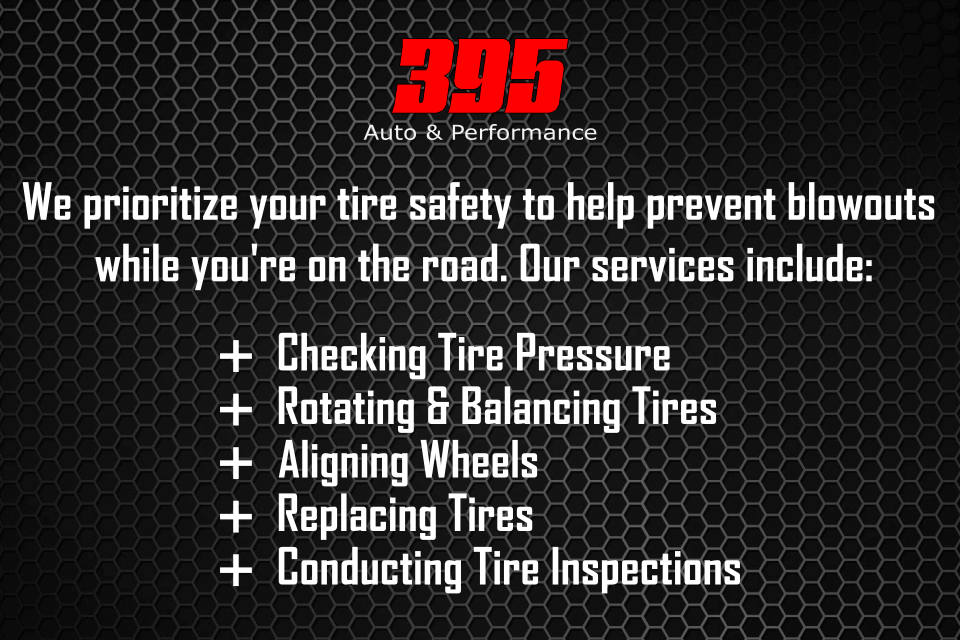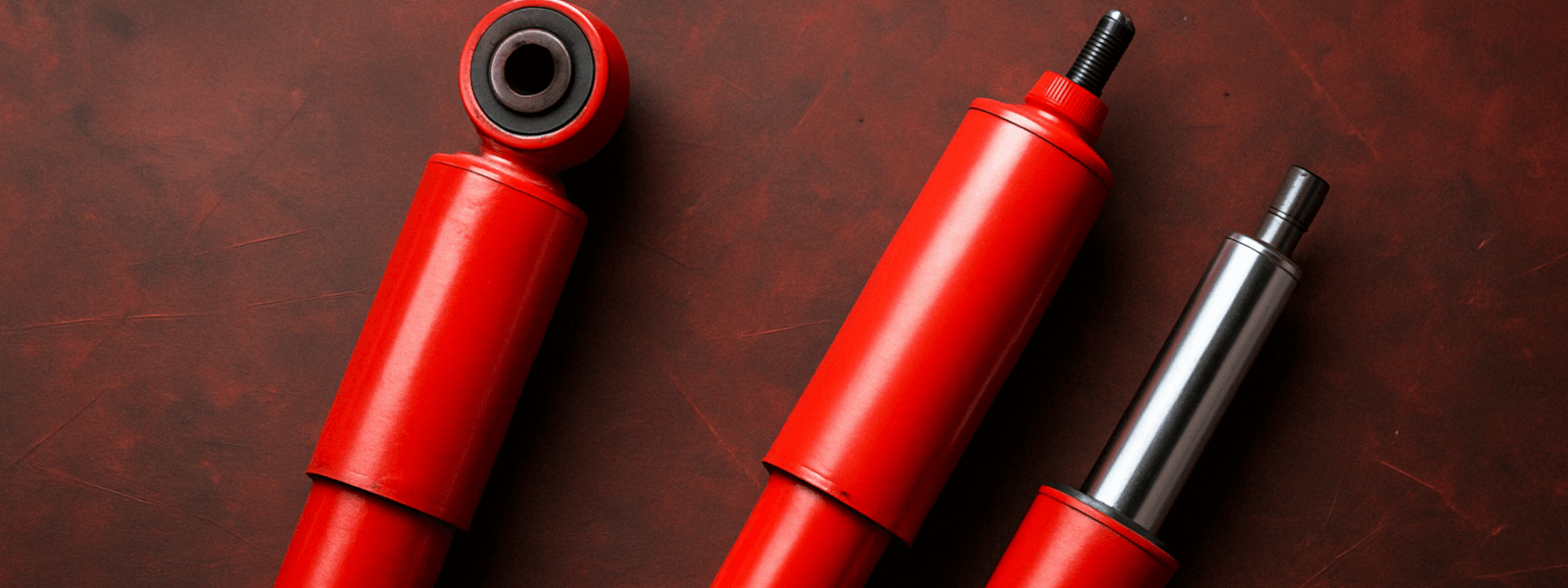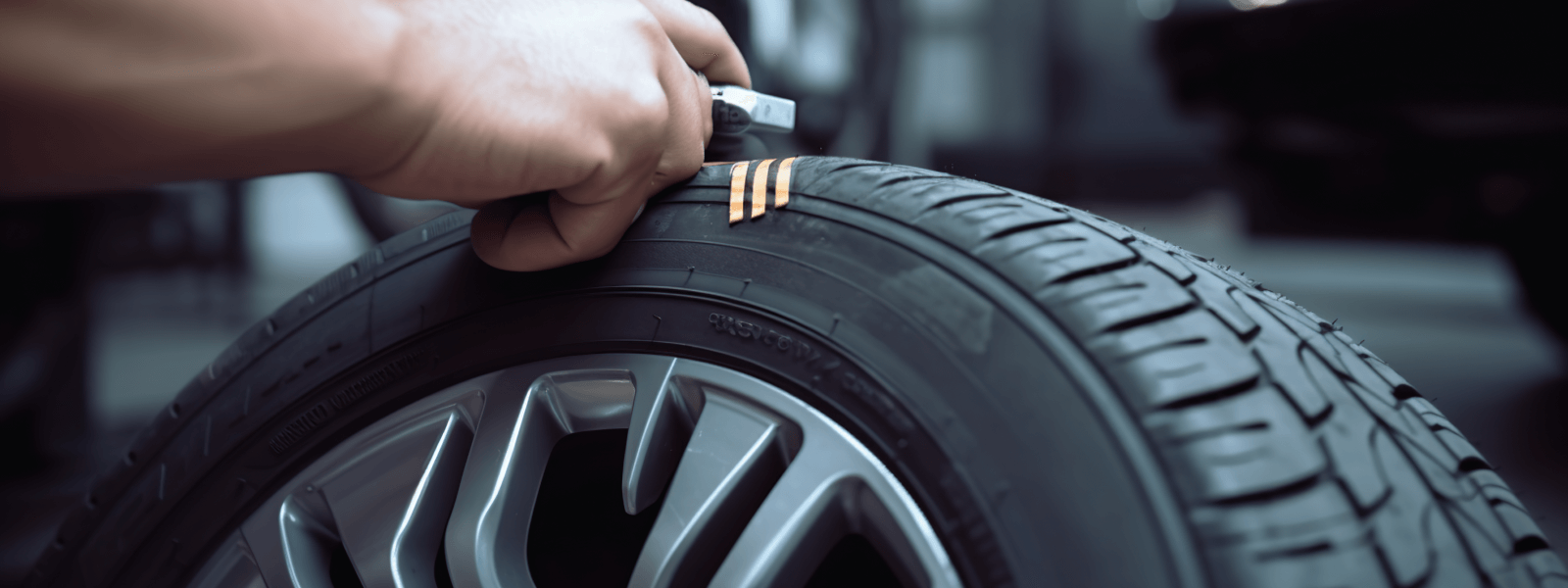Understanding and Preventing Tire Blowouts

The Terrifying Reality of Tire Blowouts on the Highway
Imagine this: You're cruising down the highway, traffic flowing smoothly, when suddenly – BANG! Your car jerks violently to one side. The steering wheel fights against your grip, and a loud flapping noise fills the air.
This is the frightening reality of a tire blowout on the highway, a situation that can quickly spiral into a dangerous loss of control, potentially resulting in accidents and serious injuries. Experiencing a tire blowout on the highway is truly alarming.
At 395 Auto & Performance, we recognize the fear and anxiety that this situation can bring. That's why we're dedicated to equipping drivers with the knowledge and resources they need to prevent tire blowouts on the highway and manage them safely if they do happen.
In this article, we will explore the causes of tire blowouts on the highway, the warning signs to watch for, and essential preventative measures, empowering you to drive with confidence.
What Causes Tire Blowouts?
Several factors can lead to a tire blowout on the highway. Recognizing these causes is essential for prevention:
Highway Tire Blowouts are Often Caused by Underinflation
When a tire is underinflated, it flexes too much as it rolls. This excessive flexing generates heat, which can compromise the tire's structure and ultimately result in a blowout. Underinflation is a common reason for tire blowouts on the highway.
Overinflation is Another Risk Factor for Tire Blowouts on the Highway
While underinflation is often the main issue, overinflation can also heighten the risk of a blowout. Tires that are overinflated are stiffer and more vulnerable to damage from potholes, debris, or other road hazards, which can lead to a blowout.
Road Hazards That Cause Tire Blowouts: Potholes and Debris
Hazards like potholes, sharp objects, and debris can cause immediate damage to tires, increasing the likelihood of a blowout. These impacts can create cuts, punctures, or internal damage that weakens the tire, making it more susceptible to failure.
Worn and Aged Tires are a Silent Threat on the Highway
Over time, tires naturally deteriorate due to exposure to sunlight, temperature changes, and regular use. The rubber can become brittle, and sidewalls may develop cracks. This deterioration raises the risk of a blowout, even if the tire seems to have enough tread.
Manufacturing Defects and Tire Blowouts on the Highway
Although infrequent, manufacturing defects can sometimes lead to tire blowouts. These flaws may weaken the tire's structure, making it more likely to fail.
Recognizing the Warning Signs of an Impending Tire Blowout
Recognizing the warning signs of a potential tire blowout while driving on the highway can provide you with valuable time to respond and possibly avert a hazardous situation:
Heed the Warning: Vibrations and Shaking Can Signal an Impending Tire Blowout
If you notice unusual vibrations or shaking in the steering wheel or throughout the vehicle, it could be an early indication of a tire issue that might result in a blowout. These vibrations may become more noticeable at higher speeds.
Don't Ignore Bulges or Blisters: They Can Signal an Imminent Tire Blowout
Regularly check your tires for any bulges or blisters on the sidewalls. These are strong signs of internal damage and significantly heighten the risk of a blowout while driving.
Listen for Unusual Tire Noises: They Could Indicate a Blowout Risk
Pay attention to any strange sounds coming from your tires, such as thumping, slapping, or hissing. These noises can suggest tire damage or a slow leak that could lead to a blowout on the highway.
Proactive Tire Maintenance to Prevent Tire Blowouts
Proactive tire maintenance is the best way to prevent tire blowouts on the highway. By following these simple steps, you can significantly lower your risk:
Regular Tire Pressure Checks are Essential for Preventing Tire Blowouts on the Highway
It's important to check your tire pressure regularly (at least once a month and before long trips). Maintaining the correct tire pressure ensures optimal performance, reduces heat buildup, and minimizes the chances of a tire blowout on the highway. You can find the recommended tire pressure for your vehicle on a sticker inside the driver's side doorjamb or in your owner's manual.
Regular Tire Rotation and Balancing Extend Tire Life and Help Prevent Blowouts
Regularly rotating and balancing your tires helps promote even wear, which extends their lifespan and reduces the risk of a blowout while driving.
Wheel Alignment Helps Prevent Uneven Tire Wear and Blowouts
Keeping your wheels properly aligned prevents uneven tire wear, which can lead to premature tire failure and increase the likelihood of a blowout on the highway.
Don't Skip Tire Inspections: They Can Help Prevent Dangerous Blowouts
Make it a habit to inspect your tires for any signs of damage, such as cuts, punctures, bulges, or uneven wear. Early detection can help you avoid a tire blowout on the highway.
Choosing the Right Tires for Your Vehicle is A Key Factor in Preventing Tire Blowouts on the Highway
It's crucial to select the right tires for your vehicle and driving conditions to ensure safety and performance. Using tires that aren't suitable for your vehicle can heighten the risk of a blowout on the highway.
What to Do During a Tire Blowout on the Highway: Immediate Actions
Experiencing a tire blowout on the highway can be a terrifying situation, but knowing how to respond can greatly minimize the chances of an accident:
Maintain a Firm Grip on the Steering Wheel
This is crucial during a tire blowout on the highway. The first thing you need to do is keep a firm grip on the steering wheel with both hands. A blowout will cause your vehicle to veer sharply to one side, so maintaining control is vital.
Avoid Hard Braking During a Tire Blowout to Maintain Control
It's important to resist the temptation to hit the brakes hard. Slamming on the brakes during a blowout can lead to a loss of control, especially if you're traveling at high speeds.
In The Event of a Blowout, Steer Gently to a Safe Area
After regaining control of the steering, carefully guide your vehicle to a safe spot off the highway. Make sure to avoid any sudden turns or swerving.
Use Your Hazard Lights to Signal Distress After A Blowout
Once you are safely off the road, turn on your hazard lights to alert other drivers to your situation.

What to Do After a Tire Blowout: Post-Incident Procedures
After you’ve safely pulled over due to a tire blowout on the highway, follow these steps:
Assess the Situation: Evaluating the Damage After a Tire Blowout on the Highway
Check how badly your tire and wheel are damaged. Also, look for any other potential issues with your vehicle.
Contact Roadside Assistance
Getting Help After a Tire Blowout on the Highway: If you can’t or don’t want to change the tire yourself, reach out to roadside assistance.
Changing a Tire Safely (If Necessary)
A Guide After a Tire Blowout on the Highway: If you decide to change the tire yourself, make sure you’re in a safe spot away from traffic. Refer to your owner's manual for detailed instructions on how to change a tire safely. Always prioritize your safety when dealing with a tire blowout on the highway.
395 Auto & Performance is Your Partner in Tire Safety
At 395 Auto & Performance, we prioritize your tire safety to help prevent blowouts while you're on the road. Our services include:
- Checking tire pressure
- Rotating and balancing tires
- Aligning wheels
- Replacing tires
- Conducting tire inspections
Book a tire inspection with us today
to make sure your tires are in excellent shape and reduce the chances of a blowout on the highway.
Driving with Confidence and Protection Against Tire Blowouts
Experiencing a tire blowout on the highway can be frightening, but you can greatly minimize your risk by understanding the causes, being aware of the warning signs, and taking proactive measures for tire maintenance.
It's important to keep your tire pressure at the correct level, check your tires regularly, and know how to respond if a blowout occurs while driving.
At 395 Auto & Performance, we are committed to helping you drive with peace of mind. By focusing on tire safety, you can enjoy safer travels on the road.
FAQs About Tire Blowouts on the Highway
What are the most common causes of tire blowouts on the highway?
The most frequent causes of tire blowouts on the highway include underinflation, road hazards, tire age and wear, and occasionally overinflation.
How can I tell if my tires are about to blow out on the road?
To identify if your tires might blow out while driving on the highway, watch for signs like vibrations, bulges or blisters on the sidewall, and any strange noises.
What should I do immediately if my tire blows out while driving?
If you experience a tire blowout on the highway, grip the steering wheel firmly, avoid slamming on the brakes, gently steer to a safe area, and turn on your hazard lights.
How often should I have my tires checked to prevent tire blowouts?
It's advisable to check your tire pressure at least once a month and have your tires inspected by a professional regularly to help prevent blowouts.
Can run-flat tires prevent tire blowouts on the highway?
While run-flat tires can let you drive a short distance after a puncture, they don't stop punctures or other issues that can lead to tire blowouts on the highway.
Can I mix different tire brands or tread patterns?
It's best to avoid mixing different tire brands or tread patterns on the same axle, as this can adversely affect your vehicle's handling and stability.







